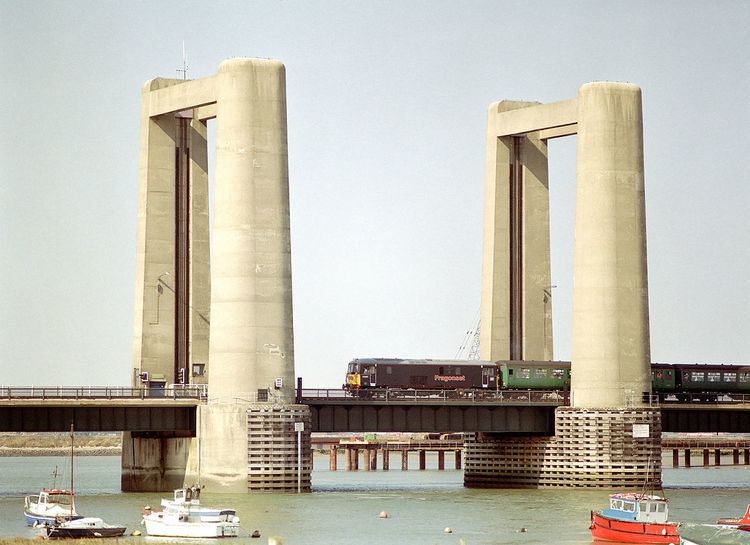Clearance above 120 feet (37 m) Width 15 m Body of water The Swale | Design Vertical lift bridge Opened 1960 Longest span 37 m Bridge type Vertical-lift bridge | |
 | ||
Carries 2 lane roadsingle track railwaypedestrians Similar Sheppey Crossing, Chillenden Windmill, Union Mill - Cranbrook, Swale railway station, Deal Timeball | ||
Kingsferry bridge sheppey sheerness ship going under
The Kingsferry Bridge is a combined road and railway vertical-lift bridge connecting the Isle of Sheppey to mainland Kent in South East England. It was designed by Mott, Hay and Anderson, and built by John Howard, with Dorman Long and Sir William Arrol & Co. The bridge is a 7 span structure with central lifting span.
Contents
- Kingsferry bridge sheppey sheerness ship going under
- Kingsferry bridge
- Construction Details
- Mechanics
- ANPR
- References
The first bridge on the site had been a railway bascule bridge built in 1860 as part of the London, Chatham and Dover Railway. This was replaced in 1904 by a Scherzer-type bascule bridge. On 17 December 1922, the Norwegian cargo ship Gyp collided with the bridge, damaging it so badly that it took ten months to repair and re-open the bridge. It was eventually replaced in turn by the present bridge.
Swale railway station is at the southern end of the bridge which is regarded by Network Rail as a "railway crossing". The A249 was carried on the bridge until the opening of a new fixed Sheppey crossing in 2006.
Kingsferry bridge
Construction Details
Each span comprises 2No. riveted longitudinal steel deck girders, supporting riveted cross girders, which in turn support a reinforced concrete slab deck. The bridge has two sets of approach spans, each of which has three spans, either side of the central main lifting span. Each set of three spans consists of two simply supported end spans which continue as cantilevers approximately 1/5 span into the middle span. The central 3/5 span sections are simply supported drop in spans supported by halving joints. The main span is a structurally independent lifting span. The bearings are inset from the end lifting beams. Spans 1, 3, 5 and 7 are 24.994m c/c of bearings. Spans 2 and 6 are 26.213m, with halving joints 5.334m from both end and a 15.547m suspended span. The central lifting span, Span 4, is 31.242m c/c of bearings, with cantilevers of 3.124m either end to the lifting cross girders. The approach spans have cross girders spaced 2.438m apart, and the lifting girder has cross girders spaced 6.248m.
Substructure:The abutments are of a cellular concrete construction. Pier 1, 2, 5 and 6 comprise 5 No. reinforced concrete circular caisson piles, formed as piers. They have a diameter of 1.37m and spaced at 5.49 between centres. A 4.57m high by 1.83m deep reinforced concrete cap sits above the piers.
Piers 3 and 4 support the lifting span in addition to the approach spans. They are constructed of a pair of circular reinforced concrete caissons founded in the river bed. The caissons are linked by a concrete structure at approximately low tide level which accommodates the machinery room and bearings for the lifting span. Two concrete towers extend above road level to support the lifting cables and counterweights, in addition to housing the mess rooms and bridge control room. The towers are braced near the top by 2 No. concrete beams.
Below river bed level, there is a cast iron subway linking piers 3 and 4 of the lifting span.
Mechanics
The bridge is powered by an electric motor beneath the road. The bridge has engine rooms on either side, which operate the wire ropes and counterweights that lift and lower the bridge. The bridge has been raised over 100,000 times and every lift has to be recorded. The bridge can only be lifted when the Sittingbourne railway signalman gives authorization, once a train travelling across the bridge has passed the relevant track section.
The maximum bridge lifting height is 84 feet and, when full height has been attained, a klaxon is sounded for confirmation.
ANPR
The police borrowed £73,000 from Swale Council to place an order for an automatic number plate recognition system (ANPR), to be installed on both the Sheppey Crossing and the Kingsferry Bridge in 2010.
